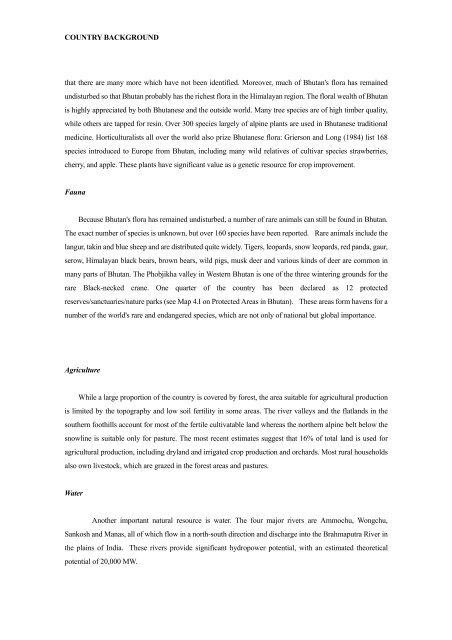COUNTRY BACKGROUND - Gross National Happiness Commission
COUNTRY BACKGROUND - Gross National Happiness Commission
COUNTRY BACKGROUND - Gross National Happiness Commission
Create successful ePaper yourself
Turn your PDF publications into a flip-book with our unique Google optimized e-Paper software.
<strong>COUNTRY</strong> <strong>BACKGROUND</strong><br />
that there are many more which have not been identified. Moreover, much of Bhutan's flora has remained<br />
undisturbed so that Bhutan probably has the richest flora in the Himalayan region. The floral wealth of Bhutan<br />
is highly appreciated by both Bhutanese and the outside world. Many tree species are of high timber quality,<br />
while others are tapped for resin. Over 300 species largely of alpine plants are used in Bhutanese traditional<br />
medicine. Horticulturalists all over the world also prize Bhutanese flora: Grierson and Long (1984) list 168<br />
species introduced to Europe from Bhutan, including many wild relatives of cultivar species strawberries,<br />
cherry, and apple. These plants have significant value as a genetic resource for crop improvement.<br />
Fauna<br />
Because Bhutan's flora has remained undisturbed, a number of rare animals can still be found in Bhutan.<br />
The exact number of species is unknown, but over 160 species have been reported. Rare animals include the<br />
langur, takin and blue sheep and are distributed quite widely. Tigers, leopards, snow leopards, red panda, gaur,<br />
serow, Himalayan black bears, brown bears, wild pigs, musk deer and various kinds of deer are common in<br />
many parts of Bhutan. The Phobjikha valley in Western Bhutan is one of the three wintering grounds for the<br />
rare Black-necked crane. One quarter of the country has been declared as 12 protected<br />
reserves/sanctuaries/nature parks (see Map 4.I on Protected Areas in Bhutan). These areas form havens for a<br />
number of the world's rare and endangered species, which are not only of national but global importance.<br />
Agriculture<br />
While a large proportion of the country is covered by forest, the area suitable for agricultural production<br />
is limited by the topography and low soil fertility in some areas. The river valleys and the flatlands in the<br />
southern foothills account for most of the fertile cultivatable land whereas the northern alpine belt below the<br />
snowline is suitable only for pasture. The most recent estimates suggest that 16% of total land is used for<br />
agricultural production, including dryland and irrigated crop production and orchards. Most rural households<br />
also own livestock, which are grazed in the forest areas and pastures.<br />
Water<br />
Another important natural resource is water. The four major rivers are Ammochu, Wongchu,<br />
Sankosh and Manas, all of which flow in a north-south direction and discharge into the Brahmaputra River in<br />
the plains of India. These rivers provide significant hydropower potential, with an estimated theoretical<br />
potential of 20,000 MW.

















